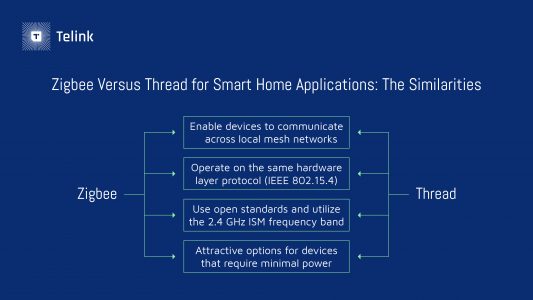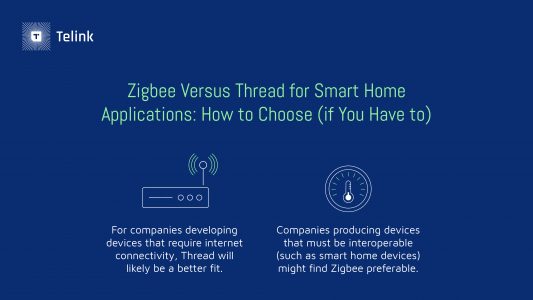



PLEASE ROTATE ME


Telink Staff
April 20, 2020
Applications

As smart device connectivity technologies compete for market share, manufacturers must think carefully about which protocols to use in their smart home offerings.
Smart home technologies are shifting how people live their lives. Internet of Things (IoT) devices afford consumers increased control over everything from energy usage to home security.
But as the market for smart devices has expanded, so has consumer demand for device interoperability. As a result, manufacturers are increasingly thinking about which open communication protocols are best for their products, and options like Zigbee and Thread have begun to come to the fore.
These two technologies have many similarities: both enable devices to communicate across local mesh networks, both operate on the same hardware layer protocol (IEEE 802.15.4), both use open standards and utilize the 2.4 GHz ISM frequency band, and both are attractive options for devices that require minimal power.

Despite these similarities, manufacturers should not conflate Zigbee and Thread, as both have clear advantages and disadvantages that make them ideal for specific products. As such, it’s important for IoT decision-makers — and consumers, as well — to be aware of what each protocol has to offer so they can make informed decisions about which to use in their devices.
Zigbee is a full stack connectivity technology and is one of the most widely used protocols in the IoT market. In addition to being the oldest and most established mesh networking protocol — a major advantage unto itself — the Zigbee insignia is widely known for its collection of clusters and cross-cluster commands, Zigbee Cluster Library (ZCL), which serves as the foundation for Dotdot, the so-called “universal language of the Internet of Things.”
Dotdot is an application layer that offers optimal interconnectivity between smart home devices. To truly understand what makes Dodot significant, it’s helpful to dig deeper into the value of application layers in IoT devices.
If the physical layer of a mesh network grants devices the ability to communicate with one another, an application layer’s job is to ensure these devices are speaking the same language. Many IoT devices come equipped with different application layers, meaning they can’t talk to one another without the use of additional routers or network configurations. As a result, consumers tend to avoid buying too many smart home devices, especially ones made by different manufacturers.
Dotdot is able to run ZCL over any application layer, meaning devices supporting Dotdot that use WiFi, Bluetooth® Low Energy, or Thread won’t have an issue connecting to Zigbee devices, and vice versa. Dotdot’s support for device-to-device communication means applications can talk directly to devices rather than going through an intermediary like a gateway or the cloud. Providing a single application layer that works over various types of mesh networks makes Zigbee an excellent choice for developers, regardless of whether they are looking to build devices for the home or business market.
When it comes to real-world use, Zigbee is well established. The Zigbee Alliance recently announced that half a billion Zigbee chipsets have been sold to date. In fact, Zigbee technologies will account for 3.8 billion IEEE 802.15.4 units by 2023 alone. In terms of smart security, ecosystem, and media integration devices — think: Amazon Echo, Philips Hue, Samsung SmartThings, etc. — in more cases than not, industry leaders have looked to Zigbee as their go-to option.
That said, while Zigbee is without a doubt the interoperability leader in the smart home world, it does have its downsides. Zigbee devices are non-IP, meaning connecting devices to the internet can be a challenge. In order for Zigbee devices to connect to the internet, users need to pair their devices with a gateway to generate IP addresses for individual nodes on their mesh network. This is less than ideal, as gateways are an additional expense and complexity to set up.
Thread is a low-power IPv6-based wireless mesh networking protocol. A unique aspect of Thread is that it does not include an application layer — in fact, the Thread protocol exists exclusively at the network layer. This can be a positive or a negative. Users who value customizability and flexibility in configuring their devices will find this to be an attractive selling point, but less experienced developers might struggle to architect and design Thread devices in a way that supports reliable interoperability.
The fact that Thread is IP-addressable is arguably its biggest advantage. While Zigbee devices have trouble connecting to the internet, Thread devices are practically built for internet connectivity. What’s more, all Thread authentication and commissioning can be smartphone-based, which is certainly a plus.

Manufacturers must be strategic when thinking about which communication protocol to use in their smart products. For companies developing devices that require internet connectivity, Thread will likely be a better fit. Conversely, companies producing devices that must be interoperable — e.g. smart home devices — might find Zigbee to be preferable.
However, in the end, it’s rather facile to think of these protocols as being in direct competition with each other. In fact, there is a great deal of room for collaboration. Thread has already joined the Zigbee Cluster Library Alliance, and is dedicated to using Dodot as the official application layer of Thread devices. By working together, Zigbee and Thread will be able to increase interoperability between their products, which will result in more consumers enjoying a wider range of IoT products in their smart homes.